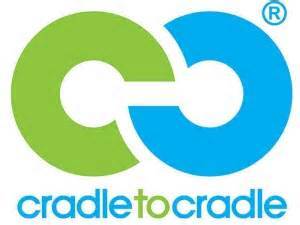
As a result, landfills are spilling over with waste. Recyclables are down-cycled and perpetually diminish in quality. Simultaneously, natural resources continue to be dipped into and challenged by the fluctuating global climate.
Instead, what if we flipped that mass-manufacturing model upside down?
From the get go, products could be designed with the intention of being reused in another technical and more sophisticated form, after they’ve fulfilled their first use. Or, products could be designed to be completely biological, so that they could naturally decompose or be broken down and returned to the earth.
While it may sound idealistic or far-reaching, the Cradle-to-Cradle (C2C) philosophy proposes just that.
As outlined by the American architect William McDonough and German chemist Michael Braungart in Cradle to Cradle: Remaking the Way We Make Things, published in 2002, the concept re-conceptualizes the mass approach to the manufacturing process.
Cradle-to-Grave Manufacturing
The current, popular cradle-to-grave practice does not consider the use of products beyond their initial use. As a result, they are less worthy and of lower quality at the end of their use cycle.
Furthermore, while recycling and reusing are less-negative options, they are not necessarily the ultimate best outcome. With those green theories, consumerism is encouraged to slow down—which is unnatural—and product creation is not reevaluated. Until the process of product creation is addressed items will continue to be made unsustainably and for single use.
Cradle-to-Cradle: Technical, Biological, Sophisticated
C2C challenges designers and consumers to rethink the life span of products. Essentially, our manufacturing process would instead be modeled after nature. Meaning, all of the pieces in a product are treated like nutrients that could either be upscaled and reused in a new fashion or returned to the earth: A sustainable, closed-loop cycle of product creation and use.
The philosophy proposes that from stage one (the product’s invention), its components fall within one of the two aforementioned categories: technical or biological. The technical realm includes environmentally friendly, nontoxic, synthetic goods. A biological spectrum includes items that are compostable.
Ultimate Goal: Cradle-to-Cradle Companies
A handful of large, popular companies are now C2C certified such as the Herman Miller furniture company, Desso textiles, Aveda cosmetics, and Van Houtum paper and forest products. In total, we would like to applaud all 159 companies, 334 active certifications, and 2,458 products that are rooted in the C2C philosophy, today.
To find out more or to obtain certification, reach out to the Cradle to Cradle Products Innovation Institute.






